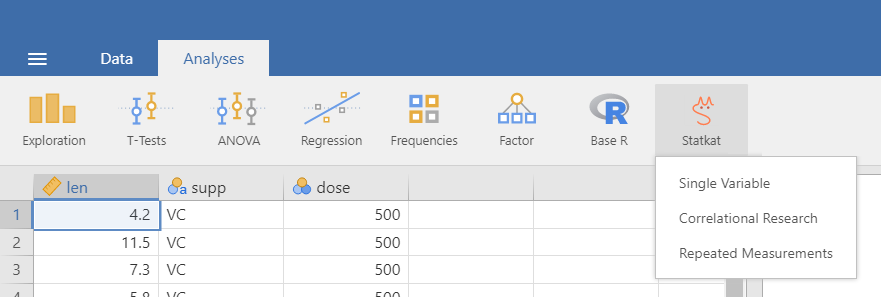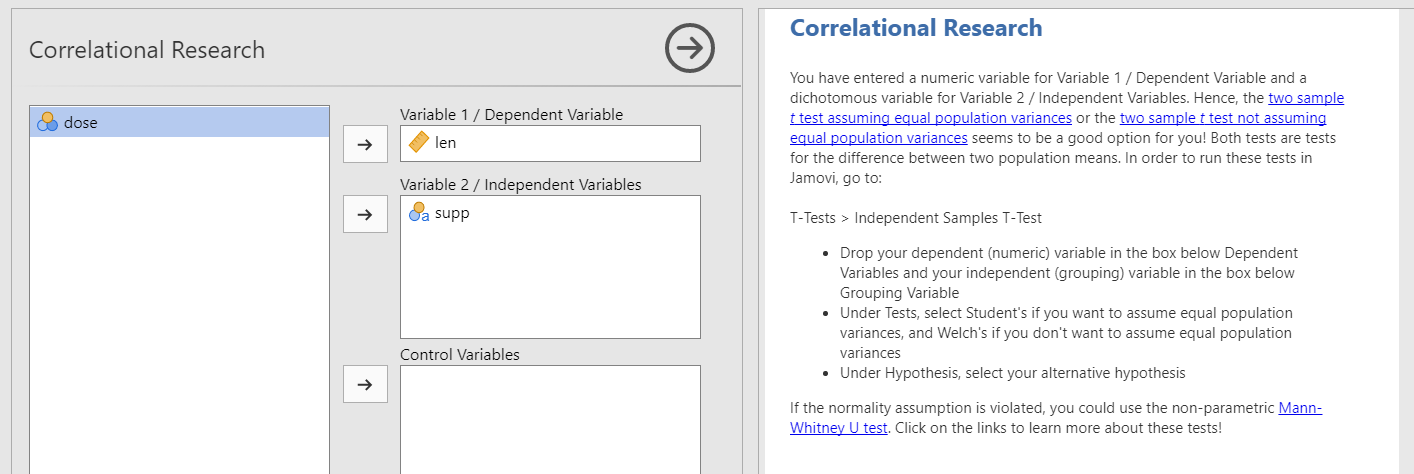tl;dr
Finding a statistical technique that is suitable for your data and research question can be challenging. The Statkat module helps you to find a statistical method that suits your needs!
Using the Statkat module
To get started, first make sure that you are working with jamovi version 0.9.1.1 or higher. Then install the Statkat module from the jamovi library and open a data set. We are going to use the Tooth Growth data set as an example data set (see Menu > Open > Examples). The Tooth Growth data set contains three variables: a numeric variable len (tooth length), a dichotomous variable supp (supplement type: vitamin C or orange juice), and a nominal variable dose (dose in milligrams per day). One question of interest could be whether there is a relationship between tooth length and supplement type. But which analysis should we use to answer this question? Let’s find out using the Statkat module. The Statkat module contains three options: Single Variable, Correlational Research, and Repeated Measurements.

Since we are interested in whether there is a relationship between tooth length and supplement type, we choose the Correlational Research option. You should also choose this option if you want to predict a variable from other variables or if you are interested in the difference between independent (unrelated) groups on a certain variable (whether there is a difference in tooth length between the two unrelated supplement groups, is just a different formulation of the example question).
About the two other options:
- Choose the Single Variable option if you are interested in only a single variable, for instance, the mean tooth length.
- Choose the Repeated Measurements option if you are interested in differences between related variables, like differences between repeated measurements over time, or differences between scores of women and their husbands.
As long as there are no variables defined for Variable 1/Dependent Variable and Variable 2/Independent Variables, the output field contains general instructions on how to use the Statkat module. The most important instruction is that the measurement levels of the variables should be set correctly, since otherwise you will end up with wrong method recommendations.
For a method recommendation given our research question, we drop the tooth length variable len in the box below Variable 1/Dependent Variable field, and the supplement type variable supp in the box below Variable 2/Independent Variables.

Based on the measurement level of the two variables, Statkat recommends to use a two sample t test, or, if the normality assumption is violated, the Mann-Whitney U test. If you need a quick refreshment of what the recommended methods are about, click on the relevant links provided in the output. The links will lead you to neat method-overview tables at the official Statkat website.
Variable 1/Dependent Variable or Variable 2/Independent Variables: Which field to use?
If your research question does not make a clear distinction between an independent variable and a dependent variable, the decision of which variable to define as Variable 1/Dependent Variable and which as Variable 2/Independent Variables can be arbitrary. But doesn’t this decision affect the recommended method? Well, in some cases it does affect the primary method recommendation, but if a simpler method can be performed by flipping the two variables, this is usually mentioned. It is then up to you which of the recommended methods you prefer. It is important to keep in mind here that none of the correlational statistical techniques can say anything about causality anyway (not even a method like regression analysis), so even if you do make a distinction between an independent and dependent variable, the statistical method will only say something about association, not causation.
Conclusion
We hope that the Statkat module will make selecting an appropriate statistical method easier. If you don’t have any data yet or if you prefer a decision tree to find an appropriate method, then Statkat’s method selection tool can be of help.
Comments